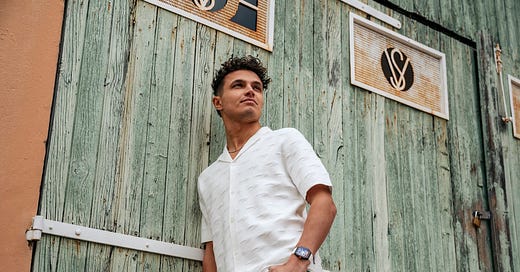Why Commercial Partnerships Could Be the Deciding Factor in F1’s Championship Race
An inside look at how McLaren’s off-track strategy is supercharging their on-track ambitions.
Welcome to Business of Speed.
In case you missed it:
If someone forwarded you this email, consider supporting independent coverage and analysis of the business of Formula 1.
There’s a myth in Formula 1 that the car with the fastest lap wins the race. But that’s only half true.
In the garage, it’s all carbon fiber and telemetry. But in the boardroom? It's contract value, activation plans, and global partnerships. If F1 is a sport of milliseconds, it’s also a business of millions—millions that fund the milliseconds.
That’s why McLaren’s latest moves off-track might be as important as anything they’ve done on it.
In modern Formula 1, the championship is won in the wind tunnel and the C-suite.
McLaren’s commercial team is no longer just a support function. It’s become a competitive advantage. According to their recent profile, the division is pivotal in keeping McLaren’s race team fully resourced and relentlessly innovative.
And they’re not just collecting logos. They’re building “catalytic partnerships," which attract capital and capability.
Here’s how it works:
Strategic Fit over sticker slaps. Brands like Google and Cisco aren’t just here for visibility—they’re plugged into McLaren’s tech stack. These partnerships shape everything from fan engagement to digital infrastructure.
Speed to Activation. McLaren’s team can launch a global campaign with a partner in days, not weeks. That’s race-pace marketing.
A Culture of Agility. The commercial and race teams work as one. Instead of silos, there’s cross-functional collaboration: business insights feed into track strategy, and vice versa.
In short, they’re treating partnership like a pit strategy. Fast, precise, and game-changing.
The Bigger Picture
For years, teams like Red Bull and Mercedes dominated because of their technical superiority and stable funding. But the budget cap has leveled the financial playing field. Today, success hinges on efficiency, innovation, and partnership strategy.
This is the era of the commercial championship.
The teams that win will not just have the fastest cars. They will also have the deepest partner ecosystems, the most aligned brand collaborations, and the ability to turn commercial capital into performance leverage.
And if you still think partnerships are just about branding, remember: Google Chrome is on the McLaren car because its engineers are in the pit lane, too, optimizing performance with real-time data pipelines.
In addition to helping to fund the race team, many of these technical partners are physical supporters of McLaren’s efforts on and off the track.
DP World's expertise and network help the team move freight globally. Dropbox enables them to transfer content across the world from the factory in Woking to the team at the track, and Dell Technologies has turbocharged our team's efficiency through its AI Factory.
These are just a few examples. Another is the hugely successful partnership with Google. “We've been incredibly successful in this area over the past few seasons,” Matt Dennington says. “Emer Acton, our Head of Human Performance, films our pit stops on an Android tablet and then uses the tablet to review the footage, comment on it, and sends it to the pit crew with notes on how we can work better as a unit.”
That’s why working with the right partners is crucial - those whose values reflect our own and whose work you genuinely believe in. Together with these partners, McLaren is delivering initiatives and campaigns, whether that’s improving environmental sustainability in F1 through the F1 Constructors’ Circularity Handbook with Deloitte, or creating unforgettable fan experiences like exclusive tickets to the F1®75 all-team season launch and a luxury hotel stay with Hilton.
Zoom Out
In F1, speed is table stakes. Sustained success comes from structural advantage, which starts with who’s in your corner.
If you’re a brand, ask yourself:
Are we fueling performance or just buying impressions?
Can our partnership make us indispensable—not just visible?
If you’re a team, ask:
Are we seeing our commercial department as an engine of innovation?
Is our brand partner just on the livery—or in the race with us?
The sport is changing. The gap between “sponsor” and “strategic ally” is widening.
McLaren’s betting big that the future of winning isn’t just under the engine cover but in the boardroom handshake.
And they just might be right.
If this sparked something, share it with a colleague who still thinks “commercial” just means logos on cars.
75 Years of Speed, Innovation, and Champions
Formula 1 is 75 today.
Three-quarters of a century since silver bullets roared through Reims. Since Fangio danced with physics. Since Enzo muttered, “aerodynamics are for people who can’t build engines.”
Formula 1 is where obsession, courage, and engineering collide at 200mph; milliseconds decide legends, every corner remembers a ghost, and every straight beckons the brave.
75 years of names etched into myth: Senna in the rain. Schumacher in scarlet. Lauda, with his face half gone, but the fire still lit. Prost, cold as calculus. Hamilton, rewriting history. Verstappen, unrelenting in a modern machine.
But F1 has never just been about drivers. It's about the mechanics who sleep on pit floors. The designers who reimagine airflow. The strategists play chess while the world blurs by. It’s about people who look at the impossible and say, “give us a weekend.”
And still, after 75 years, we watch. We feel. Our hearts quicken on formation laps. We hold our breath into Turn 1. We fall for the story over and over again.
Because F1 is the last place humans and machines chase perfection in public.
Loudly. Furiously. Beautifully.
Here’s to the next 75.







